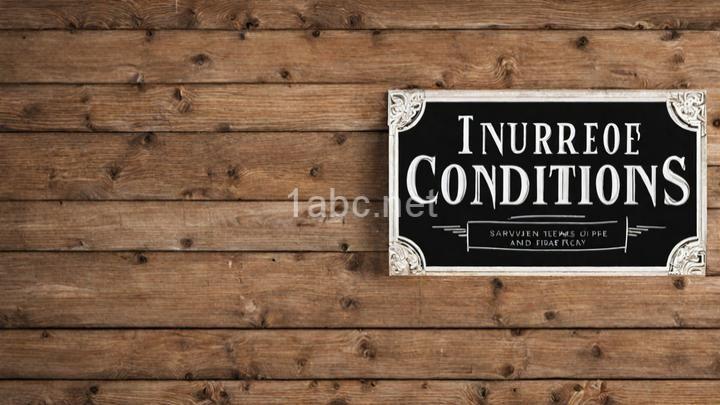Unraveling Insurance Policies: How to Make Sense of Terms and Conditions

Welcome to our blog post on understanding insurance policies! In today's post, we will be delving into the world of insurance terms and conditions, demystifying the jargon and helping you make sense of your policy. Understanding insurance policies is crucial for ensuring you have the coverage you need and avoiding any surprises when it comes time to make a claim. So, let's dive in and unravel the complexities of insurance terms and conditions!Insurance terms and conditions, often referred to as the fine print, are the specific details and requirements outlined in an insurance policy. These terms and conditions dictate the coverage, limitations, and exclusions of the policy, as well as the responsibilities and obligations of both the insurer and the policyholder. While it may be tempting to skim over these sections of your policy, it is essential to read and comprehend them fully.
Now, let's explore some commonly used insurance terminology that you may come across in your policy.
Premiums are the regular payments you make to the insurance company in exchange for coverage. These payments can be made monthly, quarterly, annually, or in other agreed-upon intervals. Premiums are based on various factors, such as the type of insurance, the extent of coverage, and the risk associated with the insured item. For example, in auto insurance, premiums may vary based on factors like the driver's age, driving history, and the make and model of the vehicle.
Deductibles are the amount of money you must pay out of pocket before your insurance coverage kicks in. For example, in health insurance, if you have a $500 deductible, you would have to pay the first $500 of medical expenses before your insurance starts covering the remaining costs. Higher deductibles often mean lower premiums, but it's important to consider your financial situation and the potential out-of-pocket expenses before choosing a deductible.
Coverage limits refer to the maximum amount an insurer will pay for a covered claim. These limits can vary depending on the type of insurance and the specific policy. For example, in homeowner's insurance, there may be separate coverage limits for the structure of your home, personal belongings, and liability claims. It's crucial to understand these limits to ensure you have adequate coverage for your needs.
Exclusions are specific circumstances or events that your insurance policy does not cover. These exclusions can vary depending on the type of insurance and the policy. For example, in auto insurance, some common exclusions may include intentional acts, racing, or using the vehicle for commercial purposes. It's important to review the exclusions in your policy to understand what is not covered.
Understanding policy conditions is another critical aspect of comprehending your insurance policy. Let's explore some common policy conditions you may encounter.
Policy renewal refers to the process of extending your insurance coverage beyond the initial policy term. It's important to review the renewal terms and conditions to ensure you are aware of any changes in coverage or premiums. Factors such as claims history, changes in risk factors, or the insurer's underwriting guidelines can impact the renewal of your policy.
The claims process is the procedure for filing and settling an insurance claim. This process typically involves notifying your insurer, providing documentation and evidence of the loss or damage, and working with the insurer to evaluate and settle the claim. It's crucial to understand the steps involved in the claims process to ensure a smooth and efficient resolution.
Cancellation policy outlines the circumstances under which your insurance policy can be canceled by either you or the insurance company. It's important to be aware of these conditions, as canceling a policy prematurely or without proper consideration can leave you without coverage when you need it most. If you decide to switch providers, it's essential to follow the proper procedures to avoid any gaps in coverage.
Now that we've covered the basics of insurance terms and conditions, let's explore some tips for decoding the jargon and understanding your policy.
First and foremost, read your policy carefully. Take the time to go through each section, paying close attention to the terms and conditions. Insurance policies can be complex documents, so it's important to read every word to ensure you understand what is covered, what is excluded, and what your responsibilities are as the policyholder.
If you come across any terms or conditions that are unclear, don't hesitate to ask questions. Contact your insurer's customer service or consult with an agent to seek clarification. They are there to assist you and can provide valuable insights into the intricacies of your policy.
If you find yourself struggling to understand your insurance policy despite your best efforts, consider seeking professional help. Insurance professionals, such as brokers or advisors, specialize in navigating the complexities of insurance policies. They can provide expert advice and guidance tailored to your specific needs, ensuring you have a clear understanding of your coverage.
In conclusion, understanding insurance terms and conditions is vital for protecting yourself financially and ensuring you have the coverage you need. By taking the time to unravel the complexities of your policy, you can make informed decisions and avoid any surprises when it comes time to make a claim. Remember, we're here to help you navigate through the often confusing world of insurance. Stay tuned for more informative articles!
FREQUENTLY ASKED QUESTIONS
What types of insurance policies are covered?
When it comes to insurance policies, there are various types that are commonly covered. Some of the most common types include:
-
Auto Insurance: This coverage protects you in the event of accidents, theft, or damage to your vehicle.
-
Homeowners or Renters Insurance: This policy provides coverage for your home or rental property, protecting against damage, theft, or liability.
-
Health Insurance: This policy helps cover medical expenses, including doctor visits, hospital stays, and prescription medications.
-
Life Insurance: This coverage provides financial protection to your loved ones in the event of your passing, helping to cover expenses like funeral costs and outstanding debts.
-
Travel Insurance: This policy offers protection for unexpected events that may occur while you are traveling, such as trip cancellations, lost luggage, or medical emergencies.
-
Business Insurance: This type of policy helps protect your business from various risks, including property damage, liability claims, and loss of income.
-
Disability Insurance: This coverage provides financial support if you are unable to work due to a disability or illness.
-
Umbrella Insurance: This policy offers additional liability coverage beyond what your other insurance policies provide, giving you extra protection.
It's important to note that the specific coverage and terms of these policies may vary depending on the insurance provider and the type of policy you choose. It's always recommended to review the policy details and consult with an insurance professional to ensure you have the coverage that suits your needs.
Can I trust the information provided in this content?
When determining whether to trust the information provided in this content, it's essential to consider a few factors. Firstly, you can evaluate the credibility and expertise of the source. Is the author an authority in the field or an expert in the subject matter? Additionally, it is beneficial to cross-reference the information with other reliable sources to verify its accuracy. Are there multiple reputable sources that support the claims made in the content? By doing so, you can gain a more comprehensive understanding and make an informed judgment. Remember to critically evaluate the information, consider any potential biases, and use your own discretion when deciding whether to trust the content.
How can I navigate through the content to find what I need?
To navigate through the content and find what you need, there are a few strategies you can try. First, you can use the search function on the website or platform you are using to look for specific keywords or topics. This will help you narrow down your search and find relevant information more quickly.Another helpful tip is to use the table of contents or index, if available. These tools can provide an overview of the content and help you locate specific sections or chapters that are relevant to your needs.
If you prefer a more systematic approach, you can start by skimming through the headings or subheadings of the content. This will give you a general idea of the topics covered and allow you to focus on the areas that are most relevant to you.
Additionally, you can make use of any navigation tools provided, such as hyperlinks or a sidebar menu. These can help you jump to different sections or related content.
Lastly, don't hesitate to reach out for assistance if you're having trouble finding what you need. Whether it's asking a friend, consulting a customer support representative, or seeking advice from online forums or communities, getting help from others can often lead you in the right direction.
Remember, navigating through content can sometimes be like exploring a maze, but with these strategies, you'll be well-equipped to find what you're looking for.
Can I share this content with others?
Yes, absolutely! You are more than welcome to share this content with others. Feel free to spread the word and share it with anyone you think might find it interesting or helpful. Sharing is caring, after all!



